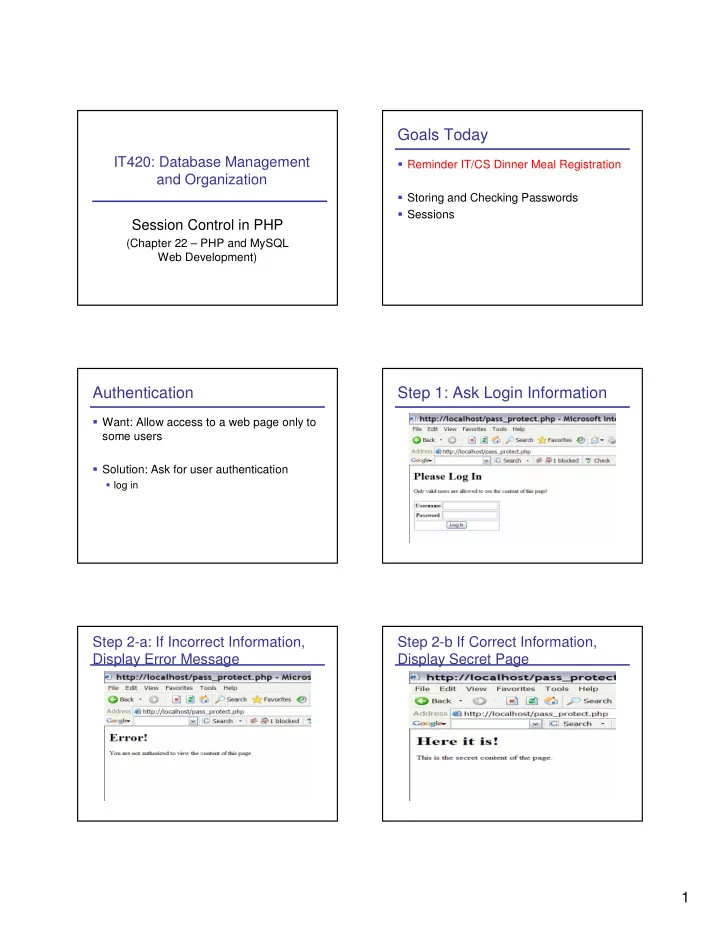

Goals Today IT420: Database Management � Reminder IT/CS Dinner Meal Registration and Organization � Storing and Checking Passwords � Sessions Session Control in PHP (Chapter 22 – PHP and MySQL Web Development) Authentication Step 1: Ask Login Information � Want: Allow access to a web page only to some users � Solution: Ask for user authentication � log in Step 2-a: If Incorrect Information, Step 2-b If Correct Information, Display Error Message Display Secret Page 1
Class Exercise pass_protect.php � Write a PHP script: � If no login info given, ask for login information � If username = ‘user’ and password = ‘pass’, � display protected content � Else, display error message Problems with the code Storing Users and Passwords � One user-name and password hard-coded � In a file on the server � Password stored as plain text � In a database � Protection for only one page � Users(Username, Password) � Password transmitted as plain text � How do we test that user information matches the information in the database? Encrypting Passwords Example Using Encrypted Password � DO NOT store passwords as plain text! � Instead of if ($name == ‘user’ && $pass == ‘password’){ � Use one-way hash functions //OK, passwords match � string sha1( string str) } � Use � Example: sha1(‘pass’) == if ($name == ‘user’ && sha1($pass) == ‘9d4e1e23bd5b727046a9e3b4b7db57bd8d6ee684 ’ ‘9d4e1e23bd5b727046a9e3b4b7db57bd8d6ee684’ ){ � Deterministic output! //OK, passwords match � Given same string, sha1 returns the same result } every time 2
Problems with the code Learned So Far… � One user-name and password hard-coded � Ask login information � Password stored as plain text � Encrypt passwords � Protection for only one page � sha1() � Store/get login information � Password transmitted as plain text � File � Database Session Control PHP Session Control � HTTP – no built-in way to maintain state � Session ID – cryptographically random number � Generated for each session between two transactions � Stored on client site � Cookie � Want: Track a user during a single session � URL � Session variables on a website – remember state � Created by PHP script � Show content personalized to user � Stored on the server site � Implement shopping carts � If session id visible (cookie or URL), session variables can be accessed by all scripts Implementing Sessions in PHP Session Demo � Start a session – session_start() � Register session variables � $_SESSION[‘myvar’] = ‘some value’ � Use session variables � session_start() � if ( isset($_SESSION[‘myvar’] ) ) { //OK code} � Deregister variables � unset($_SESSION[‘myvar’]) � Destroy session � session_destroy() 3
sesstart.php ss1.php <?php session_start(); //Create session <?php session_start(); // Use session variable //Create session variable - Save user name include(‘header.inc.php’); $_SESSION['login'] = $_POST[‘login’]; echo ‘<p>Content of $_SESSION[\'login\'] is '. $_SESSION['login']." </p>"; echo '<p><a href="ss2.php">page 2</a></p>'; //Display session variable include(‘footer.inc.php’); include(‘header.inc.php’); ?> echo ‘<p>Content of $_SESSION[\'login\'] is '. $_SESSION['login']."</p>"; echo '<p><a href="ss1.php">page 1</a></p>'; include(‘footer.inc.php’); ?> ss2.php – Use, Unset ss3.php – Cannot Use Session Var <?php session_start(); <?php session_start(); include(‘header.inc.php’); include(‘header.inc.php’); //Try use session variable // Use session variable if (empty($_SESSION['login'])) echo ‘<p>Content of $_SESSION[\'login\'] is '. echo ‘<p>$_SESSION[\'login\'] is Empty </p>'; $_SESSION['login']." </p>"; else echo ‘<p>$_SESSION[\'login\'] is Not Empty </p>'; // Unset session variable- should not be visible anymore echo ‘<p>Content of $_SESSION[\'login\'] is '. unset($_SESSION['login']); $_SESSION['login']." </p>"; include(‘footer.inc.php’); echo ‘<p>We unset the session varible</p>'; echo '<p><a href="ss3.php">page 3</a></p>'; //Destroy session $_SESSION = array(); include(‘footer.inc.php’); session_destroy(); ?> ?> (extra space) Class Exercise � Given: Login page to get user info (HTML) � action = “login.php” � method = “post” � input fields names: user and pwd � Write PHP to implement db authentication � First page: check user against the information in the database – host cs-mysqlsrvr.cs.usna.edu, database IT420, table Users, � Next pages: display only if user logged in � Logout page 4
Recommend
More recommend